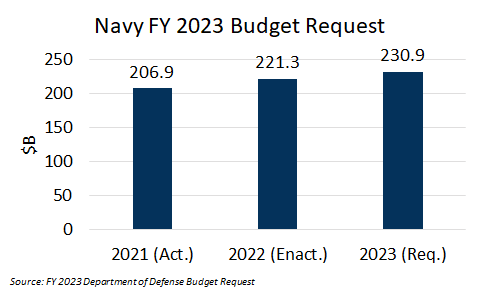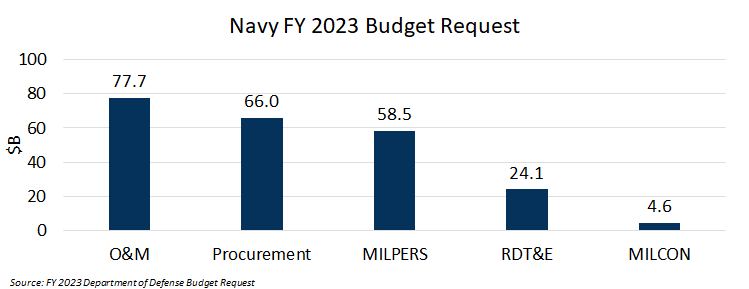Navy FY 2023 Budget Request Highlights
Published: May 19, 2022
Federal Market AnalysisBudgetInformation TechnologyNAVY
The Navy budget continues the trend of budget increases for FY 2023.
The Biden Administration released its fiscal year (FY) 2023 budget request at the end of March, after delaying its release while the White House waited to see how final FY 2022 omnibus appropriations from Congress would impact both the current FY 2022 operational budgets and plans for the upcoming fiscal year. The new FY 2023 Department of the Navy (DON) budget request reflects their strategic imperatives and ongoing modernization initiatives at the Navy and Marine Corps.
Navy FY 2023 Discretionary Budget Request
The proposed FY 2023 budget provides $230.9B in total discretionary budget authority to the Navy. This includes $50.3B for the U.S. Marine Corps (USMC). The $230.9B in total discretionary funding is a $9.6B (+4%) increase over the FY 2022 estimate of $221.3B and $23.9B (+12%) above the FY 2021 final budget of $206.9B. The three-year budget trend at the Navy continues to move upward, fueled by readiness priorities and global defense concerns, although planned growth for FY 2023 is less than increases for the current fiscal year. (See chart below.)

The FY 2023 DON budget is broken out across the traditional five appropriations categories – Operations & Maintenance (O&M); Procurement; Military Personnel (MILPERS); Research, Development, Test and Evaluation (RDT&E); and Military Construction (MILCON) - plus their Revolving and Management Funds (which was zeroed-out for FY 2023, compared to $342M and $150M in FY 2021 and FY 2022 respectively.)
The relative proportions among categories fall in historically predictable ways, with O&M and Procurement of vessels, aircraft and base support as well as Military Personnel dwarfing spending on research and development of new capabilities, although growth in the RDT&E budget is stronger than the other categories. (See chart below.)

When considering the three budget categories that tend to have the highest degree of contractor addressability among federal contractors and IT suppliers – O&M, Procurement and RDT&E – we see that some significant growth is projected. Each of these categories is measured here against FY 2021 since there is some question as to how finalized the FY 2022 data was, given the late timing of the FY 2022 final appropriations. (See chart below.)

Navy FY 2023 Information Technology
At the time of this publishing the Department of Defense has not yet released their FY 2023 IT budget artifacts, nearly two months after discretionary budgets were released. While we await specific IT budget information, there are some observable IT investments and programs within the wider Navy discretionary budget artifacts, especially their RDT&E and Procurement budgets. Based on identifiable IT-related programs in the DoD RDT&E and Procurement budgets, dollars may be bucketed into the following four IT categories – Communications, Enterprise IT, Cyber, and Software Pilot. Taken together, these categories represent nearly $6.6B in FY 2023 dollars. (See chart below.)

As noted above, the timing of when DoD will release the details of its FY 2023 IT budget plans remains uncertain. In fact, during the FY 2022 budget cycle the DoD released only very summary information, breaking with historic practice. It is unclear whether this trend of decreasing public visibility into its IT budget is the result of shifting this spending behind the veil of classified programs or an indicator of challenges with managing their IT.
---
To get a focused look into the current contracting outlook at the Navy, check out our free webinar Navy Strategic Outlook for 2022-23.
For a deeper dive into the details of the FY 2023 budget, check out our report: FY 2023 Federal Budget Request: Priorities and Opportunities.